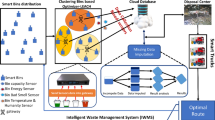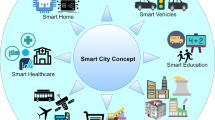Abstract
A huge number of items are associated with the Internet of Things (IoT) which is fixed with software, electronics and sensors. It has a wide variety of applications, namely smart homes, smart grids and smart cities. The sensor devices combine with Internet of Things (IoT) operates as robot system to execute data collection task. The IoT control objects, sense devices and gathers data. In crowd sourcing network there are two main issues, namely to guarantee the Quality of Service (QoS) of tasks and to reduce the data collection cost. There is also some problems arise between the task circulator and the data reporter in terms of profit. Since, IoT sensing devices have increased a lot, the relationship for finishing the task is very much important. In this paper, a novel framework called Task Unit Bit-based Spatial Coverage and Post Input density (TUBSC_PID) has been proposed. The input density is applied to estimate the contribution of a single data collector to a particular sensing task. A Task Unit Bid-based task selection strategy is proposed to choose the task which provides more contribution density and higher profit to the system. A novel spatial coverage technique is also applied to cover all the information obtained from the data collector. The present and post input density is applied to estimate the contribution of a single data collector to a particular sensing task as well as future sensing tasks. This method reduces the cost of data selection and maximizes the system profit. Experimental results predict that compared to the traditional techniques, namely Random Task selection with Input Density Reporter selection (RTCDR) and Collaborative Multi-Tasks Data Collection Scheme (CMDCS), the profit of the system is improved by 96.1%.








Similar content being viewed by others
References
Ashouri M, Lorig F, Davidsson P, Spalazzese R (2019) Edge computing simulators for IoT system design: an analysis of qualities and metrics. MDPI, Future Internet
Botta A, de Donato W, Persico V, Pescape A (2015) Integration of cloud computing and internet of things: a survey. Futur Gener Comput Syst
Estellés-Arolas E, Navarro-Giner R, González-Ladrón-de-Guevara F (2015) Crowdsourcing fundamentals: definition and typology. Springer, Advances in Crowdsourcing
Funk C, Tseng M, Rajakumar R, Ha L (2018) Community-driven crowdsourcing: data collection with local developers. proceedings of the eleventh international conference on language resources and evaluation (LREC 2018), European language resources association (ELRA), Miyazaki, Japan, pp. 1606–1609
Karger DR, Oh S, Shah D (2011) Budget-optimal task allocation for reliable crowdsourcing systems. Oper Res 62(1)
Karger DR, Oh S, Shah D (2011) Budget-optimal task allocation for reliable crowdsourcing systems. Oper Res 62(1):2011
Liao X, Li K, Yin J (2017) Separable data hiding in encrypted image based on compressive sensing and discrete fourier transform. Multimed Tools Appl 76:20739–20753
Liao X, Guo S, Yin J, Wang H, Li X, Sangaiah AK (2018) New cubic reference table based image steganography. Multimed Tools Appl 77:10033–10050
Longo A, Zappatore M, Bochicchio M, Navathe SB (2017) Crowd-sourced data collection for urban monitoring via mobile sensors. ACM Trans Internet Technol (TOIT) 18(1)
Müller MM, Salathé M (2019) Crowdbreaks: tracking health trends using public social media data and crowdsourcing. Technology report article, Public Health
Peng Z, Gui X, An J, Gui R, Ji Y (2019) TDSRC: a task-distributing system of CrowdsourcingBased on social relation cognition. Hindawi, Mob Inf Sys
Phuttharak J, Loke SW (2018) A review of mobile crowdsourcing architecture and challenges: toward crowd-empowered internet-of-things. IEEE Access 7:2169–3536
Pournajaf L, Xiong L, Sunderam V, Goryczka S (2014) Spatial task assignment for crowd sensing with cloaked locations. IEEE, 15th International Conference on Mobile Data Management
Ren Y, Liu W, Wang T, Li X (2019) A collaboration platform for effective task and data reporter selection in crowdsourcing network. IEEE Transl Content Mining 7
Roy SB, Lykourentzou I, Thirumuruganathan S, Amer-Yahia S, Das G (2015) Task-assignment optimization in knowledge intensive crowdsourcing. VLDB J 24(4):467–491
Roy SB, Lykourentzou I, Thirumuruganathan S, Amer-Yahia S, Das G (2015) Task-assignment optimization in knowledge intensive
Sarkar S, Chatterjee S, Misra S (2015) Assessment of the suitability of fog computing inthe context of internet of things. IEEE Trans Cloud Comput
Wazny K (2018) Applications of crowdsourcing in health: an overview. J Glob Health 8(1)
Xiao M, Ma K, Zhao H, Li Z, Zheng K, Zhou X (2020) SRA: secure reverse auction for task assignment in spatial crowdsourcing. IEEE Trans Knowl Data Eng 32:782–796
Zhao D, Li X-Y, Ma H (2016) Budget-feasible online incentive mechanisms for crowdsourcing tasks truthfully. IEEE/ACM Trans Netw 24(2):647–661
Zheng Y, Wang J, Li G, Cheng R, Feng J (2015) ‘QASCA: a quality-aware task assignment system for crowdsourcing Applications. ACM,SIGMOD’15
Zheng Y, Wang J, Li G, Cheng R, Feng J (2015) QASCA: a qualityaware task assignment system for crowdsourcing applications. ACM SIGMOD Int Conf Manag Data 1031–1046
Zheng F, Tao R, Maier HR, See L, Savic D, Zhang T, Chen Q, Assumpção TH, Yang P, Heidari B, Rieckermann J, Minsker B, Bi W, Cai X, Solomatine D, Popescu I (2018) Crowdsourcing methods for data collection in geophysics: state of the art, issues, and future directions. Rev Geophys 56:698–740
Zhengy Y, Wang J, Li G, Chengy R, Feng J (2015) QASCA: a quality-aware task assignment system for crowdsourcing applications. SIGMOD’15
Author information
Authors and Affiliations
Corresponding author
Additional information
Publisher’s note
Springer Nature remains neutral with regard to jurisdictional claims in published maps and institutional affiliations.
Rights and permissions
About this article
Cite this article
Rajathilagam, G., Kavitha, K. Task unit bid- spatial coverage and post input density (TUBSC_PID) based crowd sourcing network. Multimed Tools Appl 80, 5273–5286 (2021). https://doi.org/10.1007/s11042-020-09895-2
Received:
Revised:
Accepted:
Published:
Issue Date:
DOI: https://doi.org/10.1007/s11042-020-09895-2




